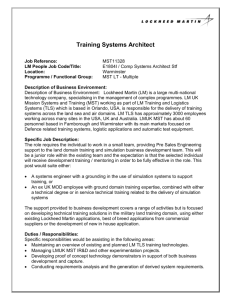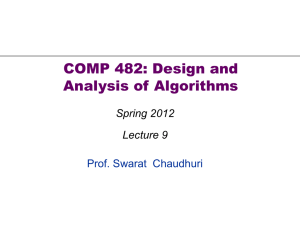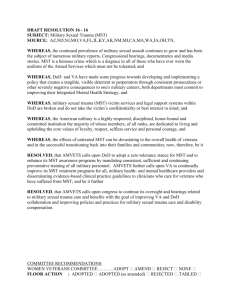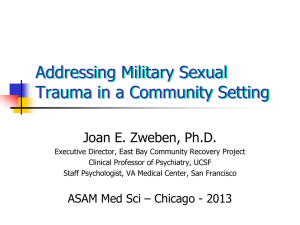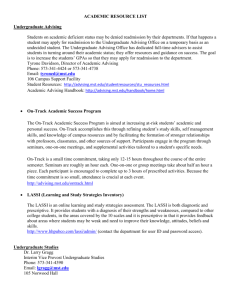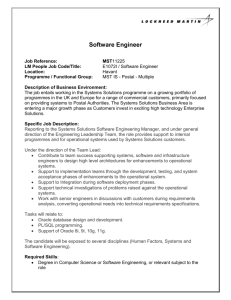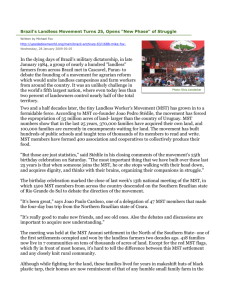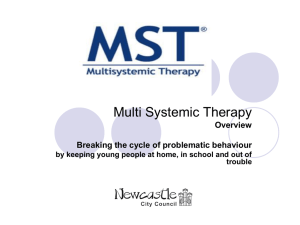Oslo_training_exercises
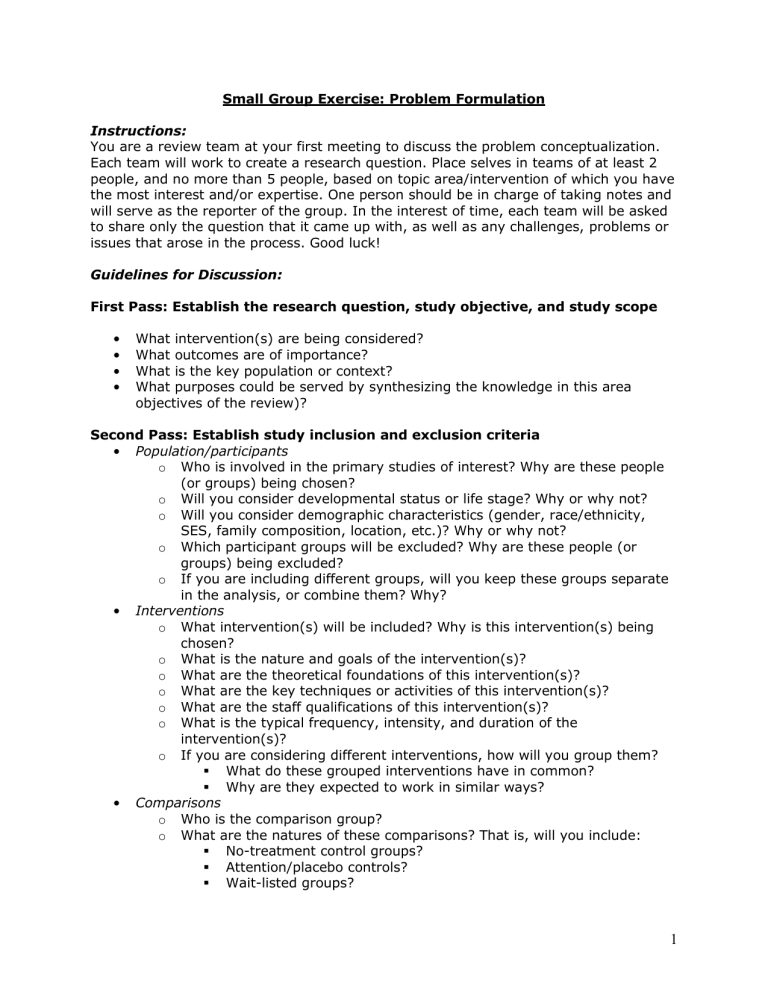
Small Group Exercise: Problem Formulation
Instructions:
You are a review team at your first meeting to discuss the problem conceptualization.
Each team will work to create a research question. Place selves in teams of at least 2 people, and no more than 5 people, based on topic area/intervention of which you have the most interest and/or expertise. One person should be in charge of taking notes and will serve as the reporter of the group. In the interest of time, each team will be asked to share only the question that it came up with, as well as any challenges, problems or issues that arose in the process. Good luck!
Guidelines for Discussion:
First Pass: Establish the research question, study objective, and study scope
• What intervention(s) are being considered?
• What outcomes are of importance?
• What is the key population or context?
• What purposes could be served by synthesizing the knowledge in this area objectives of the review)?
Second Pass: Establish study inclusion and exclusion criteria
• Population/participants o Who is involved in the primary studies of interest? Why are these people
(or groups) being chosen? o Will you consider developmental status or life stage? Why or why not? o Will you consider demographic characteristics (gender, race/ethnicity,
SES, family composition, location, etc.)? Why or why not? o Which participant groups will be excluded? Why are these people (or groups) being excluded? o If you are including different groups, will you keep these groups separate in the analysis, or combine them? Why?
• Interventions o What intervention(s) will be included? Why is this intervention(s) being chosen? o What is the nature and goals of the intervention(s)? o What are the theoretical foundations of this intervention(s)? o What are the key techniques or activities of this intervention(s)? o What are the staff qualifications of this intervention(s)? o What is the typical frequency, intensity, and duration of the intervention(s)? o If you are considering different interventions, how will you group them?
What do these grouped interventions have in common?
Why are they expected to work in similar ways?
• Comparisons o Who is the comparison group? o What are the natures of these comparisons? That is, will you include:
No-treatment control groups?
Attention/placebo controls?
Wait-listed groups?
1
Comparison groups that receive treatment as usual or usual services?
Comparisons that receive alternative treatment?
• Outcomes o What are the primary outcomes (the central goals and expected results of the intervention) that will be considered? o What are the secondary outcomes (additional possible benefits and potential harms) that will be considered? o Which outcomes will be excluded? Why? o What outcome measures will be included? Why? How reliable and valid are these measures? o What outcome measures will be excluded? Why? o What will be the timing of the outcome measures? What are the posttreatment and follow-up intervals of interest? Why?
• Study design o Will you include only random control trials/random experiments, or will you include quasi-experimental designs as well? Why? o If you will include quasi-experimental designs, what types will be included? o If you will include quasi-experimental designs, how will you consider plausible threats to validity? o What study designs will be excluded? o Will you group different types of studies in the analysis or keep them separate? Why?
• Time o What will be the start date of included studies? Why? o What will be the end date of included studies? Why?
• Language o In what languages will be the studies that are included? o Will you exclude studies based on language? Why?
• Geography o Will you exclude studies based on geography? Why?
• Users & Stakeholders
• With whom should your team consult to get the necessary answers to your
• outstanding issues and questions? Who else would you want to have input?
2
Small Group Exercise: Initial screening and eligibility decisions
Screening and Data Extraction Form
For Cochrane/Campbell Review of Effects of Multisystemic Therapy (MST)
(Littell, Campbell, Green, & Toews, 2007)
Level 1: Initial Screening
1. Is this paper about MST (perhaps in addition to other topics) ? o Yes o No o Can’t tell
2. What is this? o MST outcome evaluation o Review of MST outcome studies (and other research) o Descriptive, correlational, or case study o Theoretical or position paper, editorial, or book review o Practice guidelines or treatment manual o Can’t tell
3
Level 2: Eligibility Decisions
1. Does this study include two or more parallel cohorts (groups that received different treatments and were assessed at the same points in time)? o Yes o No o Can’t tell
2. Is it a randomized experiment? o Yes o No o Can’t tell
3. Does this study include a licensed MST program? o Yes o No o Can’t tell
4. Does it include youth (ages 10-17) with social, emotional, or behavioral problems? o Yes o No o Can’t tell
5. Is the primary presenting problem a medical condition (diabetes or HIV-positive status)? o Yes o No o Can’t tell
4
Small Group Exercise: Study Level Coding
Screening and Data Extraction Form
For Cochrane/Campbell Review of Effects of Multisystemic Therapy (MST)
(Littell, Campbell, Green, & Toews, 2007)
Level 3: Data Extraction: Study Level
Research methods
1. How were comparison/control groups formed? o Random assignment o Other (specify)
2. If random assignment, specify design o Simple/systematic (individuals/families) o Stratified/blocked (identify stratifying variables) o Yoked pairs (created by timing of enrollment into the study) o Matched pairs (identify matching variables) o Cluster (group) randomized o Other (specify) o Can't tell
3. Who performed group assignment? o Research staff o Program staff o Can’t tell o Other (specify)
4. How was random assignment performed? o computer generated o random numbers table o coins or dice o other (describe) o can't tell
5
5. How many separate sites were included in the study? o One o Two o Three o Four o Five or more
6. Was random assignment performed in the same way in all sites? o Yes o No (explain) o Can’t tell
7. How many intervention groups were there? (MST counts as one) o One (MST) o Two (MST plus what?) o Three (MST plus what?)
8. How many intervention groups are relevant for this review? o One (MST) o More than one (explain)
9. How many different control/comparison groups were there? (i.e., groups that received different treatments, not counting multiple sites) o One o Two or more (explain)
10. How many control/comparison groups are relevant for this review? o One o More than one (explain)
Settings
11. Location of interventions (check all that apply) o Urban o Suburban o Rural o Can’t tell
12. Location details (city, state, country)
6
13. Primary service sector o Juvenile justice o Mental Health o Child Welfare o Other (specify)
14. Sample size
Number of cases
Referred to study
Consented
Randomly assigned
Started treatment
Completed treatment
Completed post-tx data
Completed follow-up
15. Sample Characteristics
Gender (e.g., % male)
Youth ages
Race/ethnicity
Socioeconomic status
Family composition
Other sample characteristics
MST
MST
Control Total Pg# & Notes
Control Total Pg# & Notes
7
16. Were there any differences between program and control groups at baseline? o Yes (describe differences) o No (how do we know?) o Can’t tell
17. Was there any analysis of differences between MST program completers and drop-outs? o Yes o No o Can’t tell
18. What were the differences between MST program completers and drop-outs?
19. Was there any analysis of differences between completers and drop-outs in the control group?
20. What were the differences between completers and drop-outs in the control group?
21. MST Service Characteristics
Pg# & Notes
Duration in o Days o Weeks o Months
Hours of contact o
Per week o
Per month o
Other (explain)
Total hours of contact
Min
22. Other characteristics of MST services
Max Mean
23. Characteristics of MST staff (education, demographics, etc.)
SD
8
24. Describe methods used to insure quality of MST services (supervision, training, consultation)
25. Is there any information on program adherence (fidelity) to MST? o Yes (describe) o No o Not sure
26. Were TAM scores used/reported? o Used and reported (give results) o Used but not reported o Can’t tell o Not used
27.Were there any implementation differences between sites? (TAM scores OR any qualitative/quantitative differences) o Yes (describe differences) o No (how do we know?) o Can’t tell
29. Is information on MST program costs provided? o Cost per case o Total cost o No info
Services provided to control cases
30. Type of control group o Usual services (treatment as usual) o Alternative service (describe) o No service
31. Describe services provided to control group
32. Characteristics of staff who provided services to control cases (education, demographics, etc.)
9
Small Group Exercise: Extracting information for effect sizes
Screening and Data Extraction Form
For Cochrane/Campbell Review of Effects of Multisystemic Therapy (MST)
(Littell, Campbell, Green, & Toews, 2007)
Level 4: Outcome measures
1. When were data collected? (check all that apply) o Baseline o Post-tx o 1st follow-up (when?) o 2nd follow-up (when?) o 3rd follow-up (when?) o 4th follow-up (when?) o 5th follow-up (when?) o Other
2. Who conducted interviews? o Research staff o Program staff o Both o No interviews
3. Were data collected in the same manner for MST tx and control groups? o Yes o No (what were the differences?) o Can’t tell
10
Outcome measures
Instructions: Please enter outcome measures in the order in which they are described in the report. Note that a single outcome measure can be completed by multiple sources and at multiple points in time (data from specific sources and time-points will be entered later).
# Topic
1 Code:
Definition:
Reliablity & Validity
Info from: o Other samples o
This sample o Unclear
Info provided:
Format o Dichotomy o Continuous
Direction
High score or event is o Positive o Negative o Can’t tell
Source o Youth o Parent o
Teacher o Clinician o Admin data o Other o
Unclear
Mode Admin o Self-admin o Interview o
Other
Blind? o Yes o No o Can’t tell
Pg# & notes
Topic codes (from drop down menus): Placed (jail/hospital/foster), Arrest/convict, Delinquent, Drug/alc use, Youth psych symptoms, Social skills/peer relations, School attend, Parent psych symptoms, Family functioning, Parental supervision, Service use, Other
Note: row repeats as often as necessary to code all measures.
11
Outcome data
Please enter outcome data in the tables provided below. Enter dichotomous outcomes first, then continuous outcomes. Outcome # refers to the measures described above.
Dichotomous outcome data
Enter data only if it is provided (do not perform calculations). OR = odds ratio. Enter exact p-value if available. If covariates (control variables) are used in the analysis, please identify these variables under Statistics (cov).
Outc # Timing o Post tx o 1 st f-u o
2 nd f-u o 3 rd f-u o 4 th f-u o
5 th f-u o Other
Source o youth o parent o teacher o clinician o admin data o other
*Repeated as often as needed
Continuous outcome data
Valid Ns
MST
Control n w/ event
MST
Control
% w event
MST
Control
Statistics
OR
95%CI
Chi2
Df p-val
Other
Cov
Pg# & notes
If change/gain scores are provided, enter under "other data." If covariates (control variables) are used in the analysis, please identify these variables under Statistics (cov).
Outc # Timing o Post tx o 1 st f-u o
2 nd f-u o 3 rd f-u o 4 th f-u o
5 th f-u o
Other
Source o youth o parent o teacher o clinician o admin data o other
*Repeated as often as needed
Valid Ns
MST
Control
Means
MST
Control
SDs
MST
Control
Statistics p t
F df
ES
Other
Cov
Pg# & notes
12
